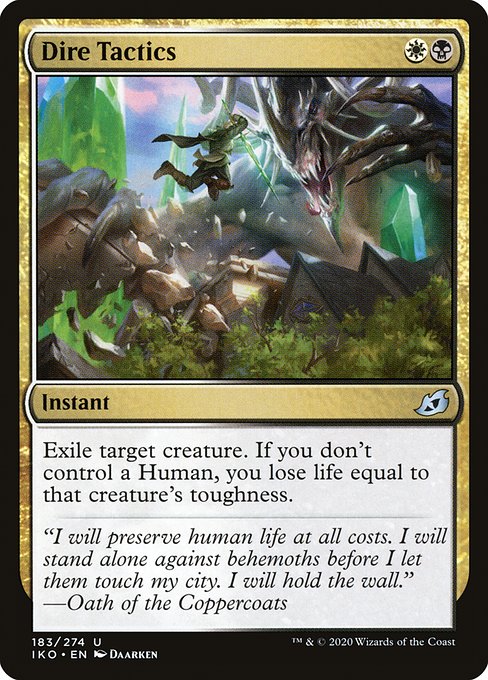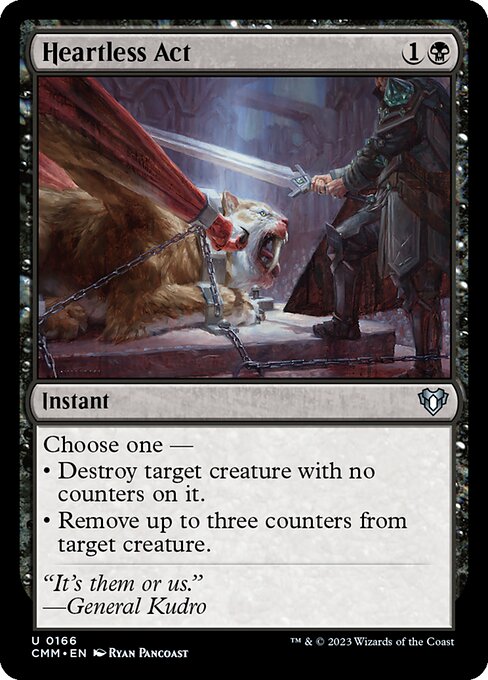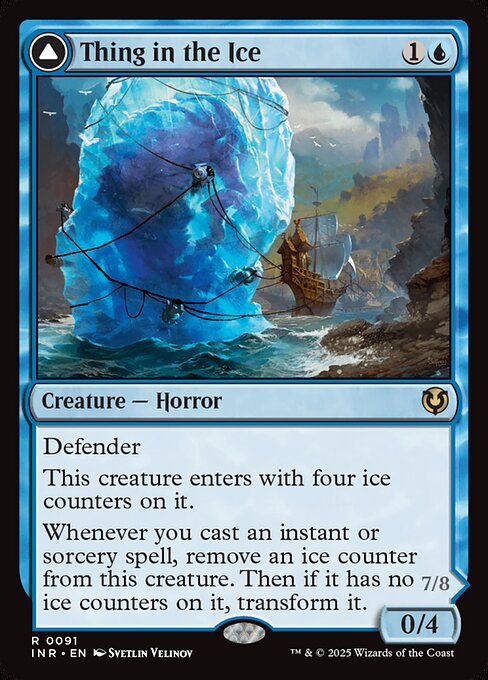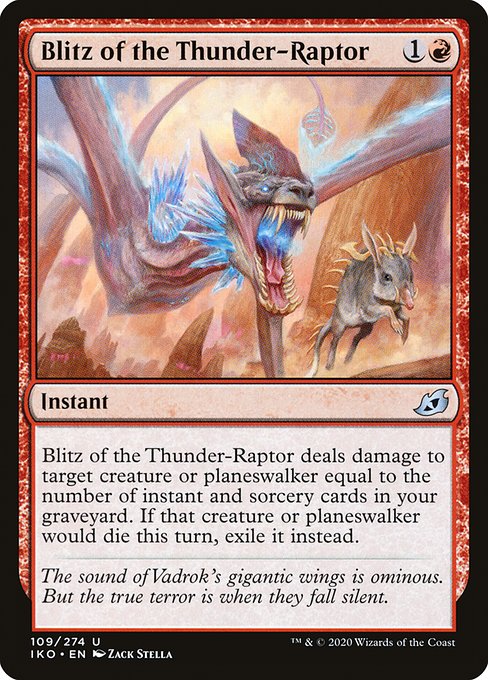Many formats in Magic tend to be shaped by threats and the answers available to deal with them. If those threats are not impactful enough or can be answered too easily, a format becomes extremely slow and grindy. On the other end of the spectrum, there are different issues: if a format contains haymakers that interact positively with removal, like Uro, Titan of Nature’s Wrath, then the metagame will constrict, squeezing certain archetypes out of the format. Against threats like Uro, decks that interact and trade resources one-for-one tend to become buried under the sheer weight of inevitability. This is why it’s important to consider removal as well as threats when evaluating format health and balance.
The great thing about removal, from the perspective of a budget Magic player, is that most of the best options available in every format are very affordable. Ikoria: Lair of Behemoths might go down in the history books for being “The Set with the Companion Mechanic,” but it’s also got some of the best removal we’ve seen in a long time. I’m doing a deep-dive into the removal in this monstrous set, and how it’s poised to impact Standard, Pioneer, Modern, and Pauper.
Dire Tactics

Any card that costs two mana and contains the words “Exile target creature” is worth consideration. There are a number of decks that could make use of Dire Tactics while getting around its drawback. In Standard, it looks likely that we’ll have either an Orzhov or Mardu Humans deck, and this would be premium removal for it. As for Pioneer, there are several White aggressive decks whose creatures are predominantly Human (White Weenie, Esper Humans, etc) that could make great use of this.
In fact, an Orzhov Humans list has just trophied the latest Pioneer League on Magic Online, running a full playset:
Orzhov Humans by MountainMaster13 (Pioneer League)
| Creatures (31) 4 Bloodsoaked Champion 4 Dauntless Bodyguard 4 Giant Killer 2 Kytheon, Hero of Akros 4 Thraben Inspector 4 Kitesail Freebooter 4 Thalia's Lieutenant 4 General Kurdo of Drannith 1 Venerated Loxodon Spells (7) 4 Dire Tactics 3 Elspeth, Sun's Nemesis | Lands (22) 4 Caves of Koilos 4 Concealed Courtyard 4 Godless Shrine 2 Mana Confluence 2 Mutavault 6 Plains Sideboard (15) 3 Fatal Push 4 Thoughtseize 1 Glare of Heresy 2 Heartless Act 2 Rest in Peace 3 Gideon of the Trials |
As for Modern, the mana base for Humans probably wouldn’t be able to support this, because most of the “mana fixing” is creature-restricted—plus they already have access to Path to Exile. Any Death’s Shadow deck in Modern that runs White (Mardu, Esper, Four- Color) might consider a single copy of Dire Tactics, however. Not only is it cheap and efficient removal, but it can help advance their gameplan in the absence of a Human creature, or even be used as a combat trick in the same way that Grixis Shadow players can target themselves with Lightning Bolt.
Heartless Act

Doom Blade is a spell whose efficiency, power, and versatility has been used as a benchmark by which all subsequent black removal has been judged. It even lends its name to the infamous “Dies to Doom Blade” argument, just to add another notch to its belt. The fact that Heartless Act is considered by many players to be better than Doom Blade should be a statement to its capability.
On Heartless Act. In theory, Doom Blade hits 80% of creatures. Discounting Ikoria, of the top 50 creatures in Standard Heartless Act hits 90%, in Modern it hits something like 98% (depending on how you count Humans & if you consider removing counters as Ballista removal). pic.twitter.com/AU3FCU9jXF
— Saffron Olive (@SaffronOlive) April 8, 2020
This a powerful removal spell that hits more creatures in most metagames than Doom Blade, Go for the Throat, or Cast Down. Standard with Ikoria may have more “creatures with counters” than usual, but that is unlikely to matter in older formats.
On top of being the latest Blade, Dire Tactics has some interesting fringe applications as well. You can reset the counters on Wall of Roots, remove -1/-1 counters caused by creatures like Soul-Scar Mage, or even remove the filibuster counters from an opponent’s Azor’s Elocutors if that somehow becomes a problem. But the best fringe interaction works with one of my favorite creatures in Magic: Thing in the Ice.

While a single Heartless Act does remove all four ice counters—three from the spells effect, plus one from the cast trigger of Thing in the Ice—you will need to cast one more spell to cause Thing’s ability to trigger and check the counters on it. This may not be ideal, but it still reduces the number of spells required to flip Thing by two. The power behind the old Modern Arclight Phoenix decks was that you could consistently flip a Thing in the Ice on turn three; this allows you to do the same, but without needing the same level of card velocity. It may seem cute, but the interaction could help more fringe Dimir or Grixis Control decks turn some of their weak matchups around, like Dredge.
Fire Prophecy

It’s not every day that we see a unique ability on a common removal spell, let alone one that could be used in a multitude of different ways, from fair to unfair. This strange tuck effect is not something we’ve seen before (apart from Vendilion Clique), and could help this card make waves in many different decks.
The fairest use for it that I can think of is in Pauper, a format that tends to focus quite heavily on interaction, synergy, and card draw. One of the most efficient card advantage engines in Pauper is made up of Kor Skyfisher and Prophetic Prism (and occasionally Ephemerate). Midrange decks that don’t use this package (Mono Black Control, Rakdos Monarch) often fall victim to being buried under the sheer value accrued, with very little they can do to mitigate it.
Magma Jet was downshifted into the format previously, possibly in an attempt to allow other decks to try and keep up with these value engines; but in the case of Magma Jet it neither kills Skyfisher nor improves the quality of cards in hand, meaning that it’s always fallen short of fulfilling the role. This is where Fire Prophecy can really shine: being able to disrupt the engine by taking out the Skyfisher is nothing new, but simultaneously being able to improve the card quality of your hand is something these decks would really welcome. It doesn’t provide card advantage, but anything that gets these decks closer to parity with the bigger players in the format will have a huge impact.
When it comes to more unfair plans for this card, we look closer at the physical positioning and zone manipulation capabilities of a card like this. We have Scry as an evergreen mechanic that can help us manipulate the bottom of our library, but that’s only able to use the top of your deck to do so. Cards like Conjurer’s Bauble can do similar, but it only takes a card from the graveyard. This card can move cards from your hand to the bottom of the library while also providing a decent effect, which is strange new territory for Magic.
This has the potential to see play across Standard, Pioneer, and Modern for all the same reasons. We could use this in Thassa’s Oracle decks, putting the Merfolk Wizard or other redundant pieces on the bottom of our deck to either protect from a Thoughtseize effect or dig for more relevant pieces. It can be used to tuck spells like Living End or targets for Polymorph-type decks (including Lukka, Coppercoat Outcast or Unpredictable Cyclone), allowing us to tuck away otherwise uncastable combo payoffs—all while removing a threat and drawing a card.
This card has gone mostly unnoticed, but its potential is enormous. It’s a great example of an extremely clever and understated design. I truly hope to see more cards like this in future.
Blitz of the Thunder-Raptor

A Lightning Bolt is only as good as the creatures it can kill.
Since time immemorial, Red has had a sort of soft cap on its ability to kill creatures due to its removal being damage-based. While Bolt and its peers (Lightning Strike, Shock, etc) have been exceptional at keeping smaller creatures in check for a long time, it’s when you face creatures with a higher toughness that they start to show their weakness. As a comparison to Black’s removal: a single Cast Down will always kill Rotting Regisaur or Steel Leaf Champion, but in this scenario Lightning Strike is way out of its depth.
Before now, you could run Harvest Pyre in formats where it’s legal (it sees very fringe play in Pauper), but it requires you to wave goodbye to your graveyard. We saw a nice inclusion in Modern Horizons in the form of Magmatic Sinkhole, and for a time it felt like R&D had found an elegant solution to Red’s main weaknesses; it was flexible, it dealt more than three damage, and it required minimal change to deck construction to include it. What we neglected to notice at the time, particularly in relation to Modern, was the real Achilles Heel of Red removal: six toughness.
Sure, you can kill a planeswalker that hasn’t been out too long, but Primeval Titan and Uro, Titan of Nature’s Wrath are just as hard to kill with Magmatic Sinkhole as they are with Lightning Bolt. Even if you do manage to kill that Wurmcoil Engine, there’s still the two tokens to take care of. The inherent tension between Snapcaster Mage and Magmatic Sinkhole is enough to push its use to just a two-of in most Blue Moon lists. Surely there’s a better answer to these problems?
Enter Blitz of the Thunder-Raptor. For just two mana, a removal spell that can essentially scale endlessly into the late game is incredible. As it can hit planeswalkers, Delver-style decks can even take care of previously insurmountable threats like Karn Liberated. With a Soul-Scar Mage on board, this can theoretically one-shot Ulamog, the Ceaseless Hunger. Granted, these are unusual examples, but my point is that these are examples of what this card can do that Magmatic Sinkhole cannot, and it can do so much more in more reasonable circumstances.
Mono Red Blitz can now use a single spell to kill Prime Time, and will likely make its presence felt in the sideboard as a replacement to Dismember. Blue Moon decks will probably add a couple of these to the main deck as a sort of Swiss Army Spell, being able to answer planeswalkers and creatures alike. The exile clause is extremely enticing, especially considering that Dredge is making the rounds again with Ox of Agonas, not to mention the aforementioned Wurmcoil Engine and Uro. The real power of this card, however, will be felt when you cast Blitz-Snap-Blitz for the first time. My confidence in Magmatic Sinkhole has bottomed out, now I’m enraptured by Blitz of the Thunder Raptor.
I believe that this will see fairly reasonable play almost anywhere that it’s legal. Standard will likely see an Izzet Spells-type deck (possibly an Izzet Phoenix build, if I can do anything about it). We could see similar in Pioneer, but my belief is that the greatest successes for this card will be within the Modern format.
At the end of the day, card evaluation is all about how something lines up against the rest of the field. Removal is why creatures with enter the battlefield effects are preferable; in a similar way, the type of removal used is why four toughness is seen as particularly good in Modern (Lightning Bolt), and three toughness is fine in Pioneer (Wild Slash).
Ikoria: Lair of Behemoths won’t change the fundamental metrics by which to judge removal or the threats we can answer with it, but it offers many strategies more options they can use to stay relevant in the face of haymakers like Uro, Titan of Nature’s Wrath, Nissa, Who Shakes the World, and Primeval Titan.
Scott is an Irish content creator and head of the budget division of the Izzet League. His primary focuses are Pioneer, Modern, and Pauper, and he can be found storming off on Twitch and Youtube.

